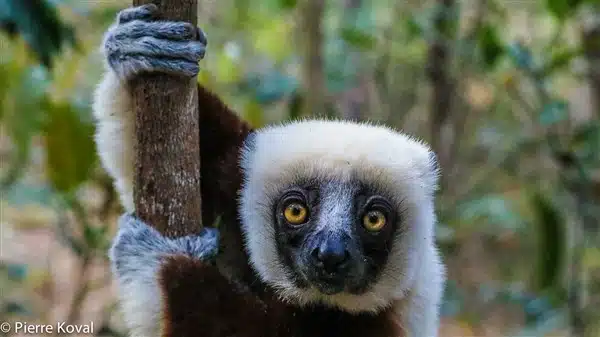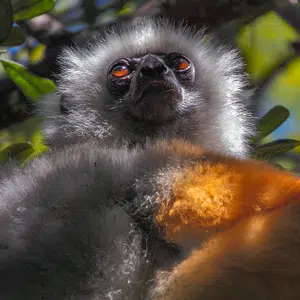Madagascar’s Lemur Families
Lemurs are tree-dwelling primates that live only in Madagascar, except for two species that were recently introduced to the Comoros.
General Description of Lemurs from Madagascar
Their ancestors likely reached the Great Island about 25 million years ago from Africa. In this 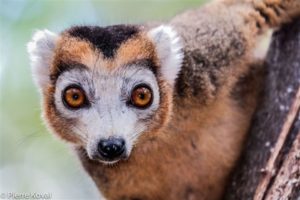
Some remained nocturnal or crepuscular, while others, Madagascar, the cradle of extinct species that disappeared more than 1,000 to 3,000 years ago, probably after the arrival of the first human populations, has seen an increase in size and adopted a daytime lifestyle.
Cranial Structure
Lemurs have large eyes with a reflective “carpet” behind the retina that allows them to see better at night. There are no bony partitions protecting the eye sockets laterally. The skull of lemurs is also less solid than that of monkeys, which have the same origin.
Adaptation to Different Biotopes
With the emergence of larger diurnal types, vision became a primary function.
The lemurs’ sense of smell has been perfected to their advantage by favoring the selection of individuals with more distant orbits, in order to better assess relief and distance.
The precision of movement is indeed crucial for these tree-dwelling animals that move in a leaping manner.
The Fur of Lemurs
The fur of lemurs is quite dense, sometimes woolly. That of the small species is dark, while that of the largest species is held in various colors, sometimes white, providing them with better protection against the sun’s rays.
Brief Description of the Different Lemurs
Arten
Cheirogales
We distinguish between the small and large cheirogale, the size of a small rodent or a squirrel.
The Cheirogales have less elongated limbs than the Makis (Lemuridae), giving them the appearance of rodents like rats. The head is more or less rounded and the ears are medium-sized or small. The tail, cylindrical and well-haired, is about half the length of the total body length.
The eyes are large, round, and forward-facing like cats.
The limbs, shaped like hands, have an opposable thumb with a flattened nail; the other fingers have flat nails, except for. The second toe, which is not claw-shaped but rather flattened like in lemurs, is abundant in fur, reddish or grey in color with reddish highlights and a whitish underside. The spaces between the eyes are generally white and the nose is blackish, more or less pronounced depending on the species. Like most lemurs, their dentition consists of four incisors on the top and bottom, six pairs of molars on each jaw, and finally two pairs of canines, which are generally more developed on the top than on the bottom.
These small primates are primarily nocturnal and live in trees, where they hunt insects but also engage in social interactions.
Feeding on almonds and fruits.
They all live only in Madagascar.
The nocturnal and discreet Cheirogales are mostly frugivorous and enter lethargy at the end of summer after building up fat reserves.
Avahis
These nocturnal leaf-eating lemurs are very discreet and relatively vulnerable to predators.
They live in small family groups and scatter by making large leaps at the slightest alarm. During the day, they remain curled up in a ball in the foliage.
The Woolly Lemur or Eastern Woolly Lemur (Avahi laniger) lives in the tropical rainforests of Madagascar.
Eastern Madagascar at low altitude (the majority is in the northern part).
They belong to the genus Avahi, of the family Indridae.
The species is classified as vulnerable. In fact, the population is declining, with habitat destruction and hunting being the main causes, although hunting is only weakly pronounced in some areas. The highest concentration of Avahi laniger is found in the Analamazaotra Special Reserve. And the highest hunting-related mortality rate is recorded in the Makira Forest.
Note that the Avahi occidentalis, which is very similar to the Woolly Avahi but slightly smaller, has long been considered a subspecies (Avahi laniger occidentalis) of the Avahi. The Avahi laniger is a species that has been highly regarded and is still being discussed in the scientific community. The Avahi occidentalis lives in the tropical rainforests of northwestern Madagascar. Some documents still assume that the Avahi laniger laniger had two subspecies, with the second being the Avahi laniger laniger.
Aye-Aye
The Aye-Aye is strictly nocturnal and has powerful incisor teeth with continuous growth. Its very wide ear flaps allow it to detect larvae in tree trunks, which it extracts with its long, agile third finger. 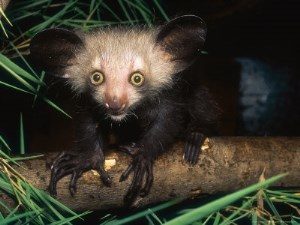
The Aye-Aye is the largest nocturnal primate in the world, with rodent-like teeth that constantly grow and an especially thin middle finger.
It is known for its unusual method of foraging: tapping on trees to find grubs, then using its forward-slanting incisors to create holes in the wood, inserting its narrow middle finger to pull out the grubs.
These lemurs are fascinating creatures with unique adaptations for survival in their environment. The Aye-Aye engages in a feeding behavior known as percussive foraging, which accounts for 41% of its feeding time. From an ecological perspective, the Aye-Aye fills the niche of a woodpecker, as it is able to penetrate wood to extract the invertebrates living inside.
The Aye-Aye is the only surviving member of the genus Daubentonia and the family Daubentoniidae.
Currently classified as endangered by the IUCN, a second species, Daubentonia robusta, appears to have become extinct at some point within the last 1000 years.
Eulémur
They are similar in size to the Lemur catta and differ from it in their genetic formula. Their dark fur and their way of life. They are diurnal or crepuscular. All eulare lemurs carry their young clinging to their fur from birth. There are five species, the most diverse of which is the Eulemur fulvus (five subspecies).
The Eulemur Fulvus Fulvus, belonging to the Lemuridae family of the Eulemur genus, is the only subspecies of Eulemur Fulvus that does not exhibit pronounced sexual dimorphism. In the northwestern part of its range, it differs from the Eulemur Mangusta by its uniform brown color on the back, while. The belly is pale and slightly grayish.
In the eastern part, it is confused with the Eulemur rubraventer, the latter having a reddish color.
The Eulemur Fulvus Fulvus has a short but dense fur and a long, slightly bushy tail at the tip. The eyes are red-orange. They growl and make themselves easily noticeable in the forest.
This medium-sized lemur measures between 85 and 100 cm and weighs between 2 and 3 kg.
Brown lemurs can be found in both moist tropical forests at mid-altitudes and in dry deciduous forests.
It can be said that it is one of the most widely distributed One of the most common species in Madagascar is the Eulemur Fulvus Fulvus, as they can adapt well to their environment even in captivity. Their diet is varied, including leaves, young shoots, flowers, and fruits.
In some areas of the East, the Eulemur Fulvus Fulvus can feed on flowers, pine, and eucalyptus plantations.
Brown lemurs typically live in groups of 3 to 12 individuals. Within the group, there are several adult males and females, along with subadults, adolescents, and juveniles in the early stages.
They do not exhibit a noticeable dominance hierarchy. Often, some activity can be observed after dark, which may be related to feeding or social interactions. The mating season of lemurs is likely dependent on the lunar cycle.
Mating occurs in May and June, with births taking place in September and October after a gestation period of about 120 days, at the beginning of the rainy season.
Typically, there is only one offspring per litter.
The young are weaned at 4 to 5 months old and reach sexual maturity at around 18 months. Communication in lemurs is generally vocal or gestural, but also through marking. The latter involves leaving an olfactory mark on plants through glands located in specific areas of the body.
It is worth noting that a Stronger scent emitted by one subspecies is stronger than the scent emitted by other lemurs.
It is so strong that even humans are able to smell it. Ano-genital marking is still the most commonly observed behavior.
The life expectancy of this species can exceed 20 years in the wild. However, the Eulemur Fulvus Fulvus Fulvus is still threatened by hunting and habitat destruction.
Mouse Lemurs
Nocturnal, they feed on insects, small vertebrates, and fruits, and spend the day in tree hollows or nests. Two subspecies, the Gray Mouse Lemur and the Red Mouse Lemur, are among the. The smallest Madagascan lemurs. Unlike the latter, the Coquerel’s Microcephalus (subspecies three times as large, sometimes also called Mirza) does not store fat reserves to spend the winter in lethargy.
Three new species of lemurs of the genus Mouse Lemur were discovered between 2013 and 2016.
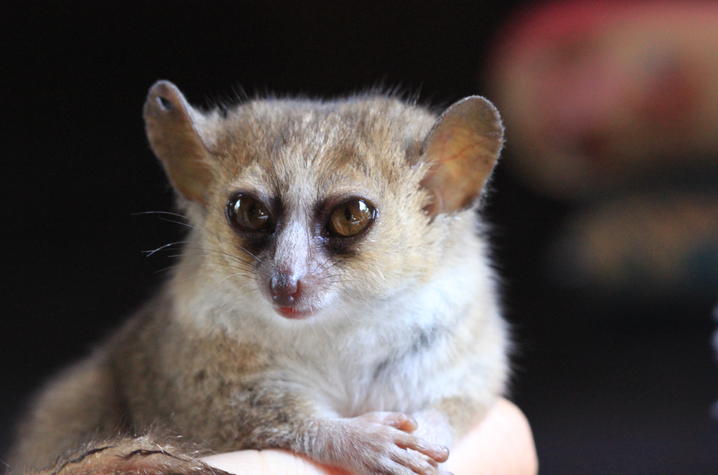
The Ganzhorn Mouse Lemur or Microcebus ganzhorni was discovered in the southwest of Madagascar in 2016. It is one of the last species of the family to be described in 2016.
The Microcebus ganzhorni belongs to the family Cheirogalidae and the genus Microcebus (mouse lemurs). Mouse lemurs are very small lemurs, most of them are the size of a hamster.
The Microcebus ganzhorni was named after Professor Jörg Ganzhorn from the Duke Lemur Center, who led the project.
Berthe’s Mouse Lemurs
Berthe’s mouse lemurs are very small. A male measures only about 9 cm in length and weighs around 30 g. Females are sometimes larger than males.
They have a two-tone dorsal fur, with cinnamon and… Yellow ocher mixed. In the abdominal area, black and light gray mix. The tail, crown, and ears are yellow-brown. The limbs are darker.
Microcebus boraha
The Microcebus boraha is one of the latest species of the family discovered and described in 2016.
Microcebus boraha belongs to the family Cheirogalidae and the genus Microcebus (mouse lemurs).
The adorable mouse lemurs were discovered in the southern part of the Island of Sainte-Marie.
Note that the word “Boraha” is another name for the Island of Sainte Marie.
Microcebus manitatra
Microcebus manitatra belongs to the family Cheirogalidae and the genus Microcebus (mouse lemur). The species was discovered in 2016. The golden Hapalemur, along with Microcebus ganzhorni and Microcebus boraha, was discovered in the southeastern part of Madagascar. The golden Hapalemur was found in a humid forest around Ranomafana in 1987, where it is believed to still reside.
Hapalemurs primarily feed on bamboo shoots and leaves. At birth, the young cling to the mother’s fur, but soon the mother leaves them hanging on a branch while she feeds.
Hapalemurs are the smallest of the diurnal lemurs. Their adult weight ranges between. weighing between 700 and 800 g.
The small Hapalemurs are characterized by their dark gray fur and monkey-like faces (flat snout like monkeys).
This species lives in the rainforests of the East, their natural habitat being bamboo forests, with thirty-two species of bamboo endemic to Madagascar.
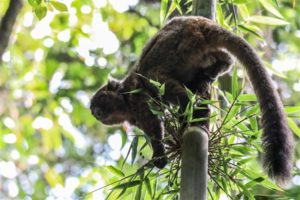
Sometimes Eat soil, actually ingesting a very high dose of cyanide that is present in the base of their food.
This promotes their digestion, although their metabolism is well adapted to this potent poison.
In groups of two to six individuals, males, females, and young live together in perfect harmony. They can live to be between 20 and 25 years old.
Phaner
As loud as microbes and Cheirogales are discreet, he lets his cries ring out all night long. They mainly feed on resins extracted from tree trunks and insect secretions.
Geographical Range
Phaner furcifer has a wide but discontinuous distribution on the island of Madagascar. The majority of the population is found in the coastal forests in the north and west of Madagascar.
Habitat
These lemurs are typically found in the moist forests in the east of Madagascar and in the dry forests of the temperate zones in the west.
They are restricted to areas where rubber-producing trees are abundant and dense. They are usually found at a height of 3 to 4 meters above the ground, but have been observed moving on the ground and. Websites/urls should not be translated.
The fork-marked lemurs can grow up to 10 meters high.
Description
The head and body length ranges from 227 to 285 mm, with the tail adding an additional 285 to 370 mm to the total length.
The weight typically ranges between 300 and 500 g. The fur is reddish-gray to brownish-gray, with the lightest fur located on the neck and head.
Fork-marked lemurs get their name from the characteristic dorsal stripe that splits on top of the head and continues on each side to the eyes.
Reproduction
Fork-marked lemurs mate in monogamous pairs. Once a bond is formed between them, the male and female share the responsibilities of raising their offspring.
Female lemurs occupy a tree hole and are found together at any given time.
Bachelor males and male bigamists have been found, but are extremely rare.
The mating system is monogamous, with limited details on the reproduction of these animals.
Catta Lemurs
Ring-tailed Lemur in English. Emblem of Madagascar, these lemurs are easily recognizable by their black and white ringed tails. When walking on the ground, they hold their tails up in the air like a question mark.
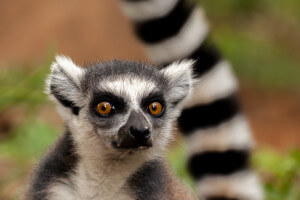
When playing, young lemurs are as agile as cats and they purr when grooming each other. Makis live in the dry forests in the south of Madagascar.
For a long time, they were protected by the Antandroy (an ethnic group from southern Madagascar) just like the Sifakas.
In fact, Makis hold their arms apart to soak up the sun, resembling a prayer, but unfortunately, the loss of traditions and deforestation threaten the species.
The Maki catta (Lemur catta) belongs to the Lemuridae family and is a distinct genus: the genus Lemur.
Makis are the most well-known lemurs, living in the dry forests of southern Madagascar.
Especially known for their daily habits, their black-and-white ringed tail (14 black stripes and 14 white stripes), and easy access to the regions where they live.
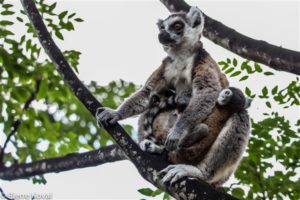
Ring-tailed lemurs are semi-arboreal and can easily be found on land. They inhabit tropical dry forests, gallery forests, or spiny forests in the southern, southwestern, and southeastern parts of Madagascar.
They can be described as omnivorous. They live in groups of 3 to 20 individuals, consisting of an equal number of males and females.
Females remain in the groups where they were born and dominate the males. Competition for dominance is common among females, even between different groups.
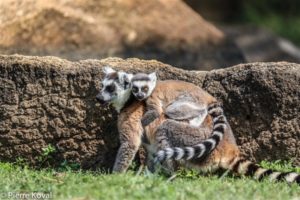
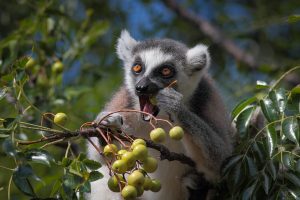
In the wild, lemurs are vulnerable due to deforestation, hunting, and natural predators: the Fossa (Cryptoprocta ferox); the Civet (Viverricula indica); the Madagascar Ground Boa (Acrantophis dumerili); and finally, due to domestic animals like stray cats and dogs.
In the southeastern region of Madagascar, local ethnic groups consider the lemurs to be sacred animals.
Lemurs are part of our wealth and heritage, so it is up to us to protect them by being aware of their invaluable value, just like their ancestors did, contributing to their preservation.
Catta lemurs live in groups (up to 30 individuals). Like the red-bellied lemurs, they carry their young clinging to their fur. Their range of sounds is very diverse.
They are particularly numerous in the Berenty Reserve and in the Anja Park near Ambalavao, where they are strictly protected.
Lepilemur
They form a very homogeneous and strictly nocturnal group.

Identification
The Milne-Edward’s Lepilemur is one of the largest in its family, with an average length of 55 cm (including tail) and a weight of about 750 g. Its fur is gray-brown, with lighter spots (head, 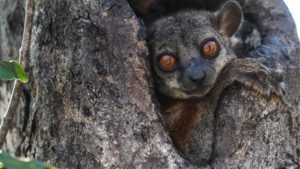
Characteristics
The Milne-Edward’s Lemur inhabits the dry forests in western Madagascar. They are nocturnal and monogamous, although a solitary lifestyle is easily noticeable. They mainly feed on leaves and flowers, with insects being a rare part of their diet.
Locations
The Milne-Edward’s Lemur lives in western Madagascar. The area where they are found is quite extensive, but there is a strong concentration in the Boeny region, between the Betsiboka River (south) and the Maevarano River (north), including the Ankarafantsika National Park and the Bongolava Massif. They can also be found further south, for example in Bemaraha.
Vari-Lemur or “Varecia” Lemur
It is almost twice the size of the Red-tailed Vari Lemur. The Varecia is the largest of the lemurs, after the Indri indri, which can reach a meter in length. It lives in the eastern rainforest of Madagascar. The female lays her 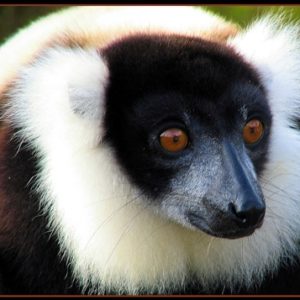
The dominant member of the group.
The Varecia, like all diurnal lemurs, is always a female.
It is the only species that gives birth to two offspring, which is very rare among lemurs in general.
In the early hours of the sun, the Varecia settles on the high sunny branches of the forest. Here too, it stands out from the others by its ability to absorb a maximum of warmth.
Instead of spreading its arms apart like other lemurs, the Varecia sits with its arms outstretched and legs extended in a sitting position.
They live in groups of six to eight individuals, sometimes only three.
In the latter case, there is a The group then consists of a couple and their offspring.
Sifakas
These large diurnal lemurs live in family groups. They move by leaping in a vertical posture. Their rarity is mainly due to deforestation.
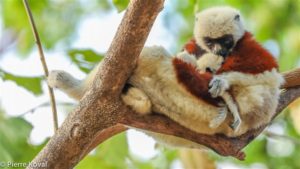
On the ground, they move on two legs in small leaps with arms spread to maintain balance.
In the trees, they can jump more than six meters. Their weight ranges from 3.4 to 4.3.
Kg. Early in the morning, they sunbathe on the high branches of the forest to accumulate maximum warmth.
Crowned sifakas are characterized by their white or yellowish fur with a brown patch on the chest and a darker black head. The muzzle is pointed and rounded.
They are found in the dry forests of western and central-western Madagascar.
They are diurnal and mainly feed on buds, leaves, fruits, and flowers.
Like all other sifakas, crowned sifakas do not drink water. They only drink the juice of the leaves and fruits they eat.
Coquerel’s Sifaka
This species, living in western and southern Madagascar, has several subspecies that differ in the shade of their fur and their location.
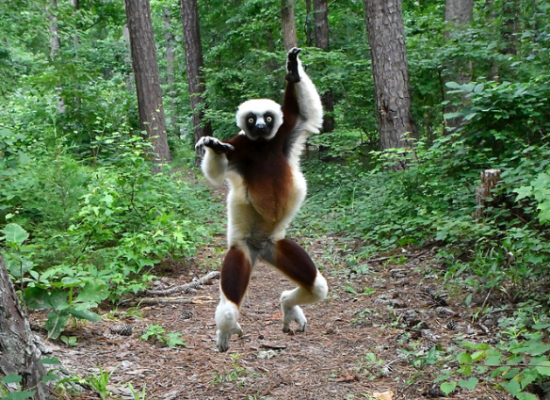 Sifakas, known as “Sifaka” in Malagasy language, are among the most evolved lemurs. Their muzzle is shorter than that of other lemurs.
Sifakas, known as “Sifaka” in Malagasy language, are among the most evolved lemurs. Their muzzle is shorter than that of other lemurs.
They are. Large animals weighing almost four kilograms. Their movements are radically different from those of other species: they move vertically in small leaps, with their arms outstretched to maintain their balance.
Sifakas have the peculiarity of moving in the thorny trees of the dry forest. They can make jumps of 6 meters through the octopus trees in southern Madagascar. Their habitat is found in the forests of the south and west. Groups vary from 3 to 10 individuals depending on the region. Groups of 6 to 8 individuals are the most commonly observed.
Early in the morning, they sunbathe on the branches. From the high branches of the forest, the Coquerel’s Prophithecus sits with arms outstretched to accumulate maximum heat. This species lives in the dry, deciduous forests of northwestern Madagascar and is one of the most beautiful Sifaka species, weighing between 3.7 kg and 4.3 kg as an adult.
Typically, it is a dominant female that leads a group of 2 to 6 individuals. On site, its picturesque movement radically distinguishes it from other lemurs. In fact, its behavior is unique and captivating. Make small vertical leaps, spreading their arms to maintain balance, which is why they are called “Dancing Lemurs”. This is due to the unique fusion of the pelvic girdle characteristic of the INDRIDAE family.
They can jump more than 6 meters from tree to tree. Coquerel’s Sifakas are folivorous and frugivorous, mainly feeding on leaves and fruits. During the rainy season, they also eat dead wood and buds. Sometimes they also enjoy tree bark during the dry season. They are a type of lemur that never drinks, as they only consume the sap of leaves, from which they derive their water. The Sifakas are characterized by their fur hydrated by the morning dew and the juice of the fruits they consume. Their reproductive period is between November and December, with births (only one pup per litter) occurring in June or July after a gestation period of 162 days.
At birth, the infant is strapped to its mother. After 60 days, it will detach from its mother’s back and stay there until six months of age to perfect its lifelong learning. The baby is weaned after 32 weeks. It reaches sexual maturity at 18 months of age. As an adult, it can.
Being expelled to found a new family is essential for a Diadem Sifaka to avoid inbreeding within its original group.
Deforestation, slash-and-burn agriculture, bushfires, and intensive hunting for their meat pose a greater threat to them than their natural predators (such as the Fosa and predatory birds that hunt newborns).
Diadem Sifaka
This species, found in the eastern forests, has several subspecies, including the Diadema, which has a very colorful fur.
The Diadem Sifaka (Sifaka being the Malagasy name for the entire genus), or Propithecus diadema, is characterized by its large size and black diadem marking on the skull. They inhabit the eastern part of Madagascar.
In some documents, the diademed sifaka has two subspecies: Prophitecus diadema diadema, which retains the name Prophitecus diadema alone, and Prophitecus diadema candidus, which became Propithecus candidus.
Their names can still be found in some documents. Additionally, Prophitecus diadema is very close in general morphology to four species of the same genus: Propithecus edwardsi, Propithecus perrieri, Propithecus tattersali, and Propithecus candidus.
In fact, they only differ in their colors.
The Diademed Sifaka belongs to the family Indridae and the genus Propithecus (Sifaka). It is classified as “critically endangered.” The destruction of their habitat, in this case.
In the eastern forests, the main threat to the species is deforestation. The current population is estimated to be between 6,000 and 10,000 individuals.
Identification
The Diademed Sifaka is the largest of the Sifakas and one of the largest lemurs, competing with the Indri Indri. It measures about 1 m in adulthood (including a 50 cm tail) and weighs around 7.5 kg, sometimes up to 8.5 kg. She has long, silky, and colorful fur; white on cheeks, forehead, and throat, black from the crown to the lower back. 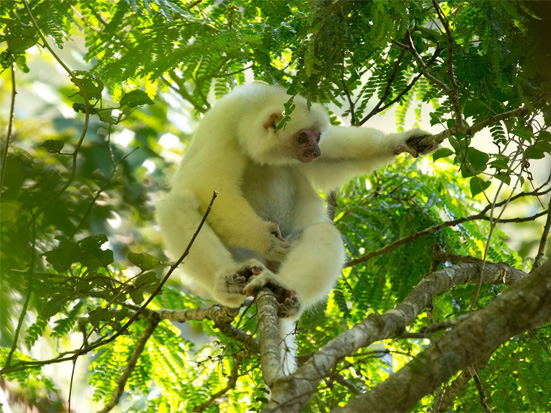
Orange-bis gelbbraun für die Gliedmaßen. Das Gesicht, die Hand und die Füße sind völlig schwarz. Schließlich sind seine Augen rotbraun.
Merkmale
Der Diadem Sifaka lebt in Gruppen von zwei bis zehn Personen. Er ist tagaktiv und tagsüber ein großer Reisender auf der Suche nach seiner Nahrung. Sie kann mehr als eine Meile pro Tag zurücklegen. Er ernährt sich von Früchten, Blüten, Samen und grünen Blättern.
Diese Tiere fühlen sich auf Bäumen wohler, da sie eher wie Seitenspringer sind. Man sieht sie nur selten auf dem Boden, wo ihre beiden gefährlichsten Raubtiere zu finden sind: das Nilkrokodil und die crocodiles.
.
Locations
The Diademed Sifaka lives in the humid forests in the East of Madagascar. They are mainly seen in the Mantadia National Park and in the Tsinjoarivo Forest.
The Candidus, all white, and Perrieri, all black.
Tattersall’s Sifaka or Golden-crowned Sifaka
This newly recognized species lives in the eastern forest. Its distribution area intersects curiously between those of two subspecies of Diademed Sifakas.
 The Golden-crowned Sifaka is a medium-sized lemur characterized by short, mostly white fur, protruding furry ears, and a gold-orange crown.
The Golden-crowned Sifaka is a medium-sized lemur characterized by short, mostly white fur, protruding furry ears, and a gold-orange crown.
It weighs about 3.5 kg. The Gold-crowned Sifaka weighs about 7.7 lbs and is approximately 50 cm (20″) long. It can be found in gallery, semi-evergreen, and dry deciduous forests, where it is mostly active during the day and sleeps in tall, emergent trees.
The diet of the Gold-crowned Sifaka mainly consists of seeds, shoots, unripe fruits, young and mature leaves, and flowers.
The size of Gold-crowned Sifaka groups varies from 3 to 10 individuals, with an average of about 5 individuals. Groups typically include 2 adults of each sex, but only 1 female reproduces each year. Within the group, females are usually dominant over males.
The Gold-crowned Sifaka is typically found in [URL]. The Manambato and Loky rivers in northeastern Madagascar limit the range of one of the most endangered lemurs. This species has one of the smallest distribution areas and documented population sizes of all lemurs.
Its geographical distribution may be limited to only 30-35 km (19-22 mi) in diameter (equivalent to an approximately circular area of 710-960 sq km (272-370 sq km)). The total population is spread across a number of discontinuous forest fragments.
The largest single population is estimated at around 2500 lemurs. Individuals estimated.
The forests in their entire limited distribution area are already highly fragmented, and the species now only occurs in isolated forest remnants surrounded by agriculture.
The main threats are gold mining and habitat loss due to conversion for agriculture.
Mining activities destroy habitat and miners hunt the region’s animals for food. Other threats include uncontrolled grass fires, wood harvesting for housing, firewood production, and logging.
Indri Lemurs
The largest lemur (70 cm) resembles sifakas in appearance but has only a stub of a tail.
The Indri Lemur Species
The Indri Lemur belongs to the order of Primates and the sub-branch of lemurs, the Indri indri is a rare species that stands out from other lemur species endemic to Madagascar, notably due to the absence of a tail, as well as its behavior.
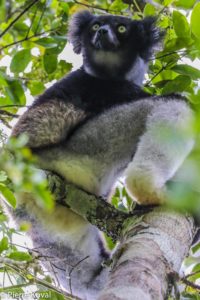 Indeed, the Indri indri, in addition to the physical peculiarity of its tail stump of less than 3 cm, which acts as a tail, has a distinguishing feature that sets it apart from its counterparts, also possessing a unique morality characterized by dissonant songs that serve to signal its presence and territory.
Indeed, the Indri indri, in addition to the physical peculiarity of its tail stump of less than 3 cm, which acts as a tail, has a distinguishing feature that sets it apart from its counterparts, also possessing a unique morality characterized by dissonant songs that serve to signal its presence and territory.
In the shadow of the fame of the Lemur Catta, a symbol of the large island and even a famous character in the movie Madagascar, the Indri remains one of the most fascinating lemur species found in Madagascar.
The Indri is rare and differs from other lemurs of the large island in its size, behavior, and diet. Indris rely on intact rainforests as they need about 30 leaves from various tropical trees. They are locally endemic and cannot survive in other habitats or in zoos.
This is a species that must be discovered, especially as it is a key player in the ecosystem of Madagascar.
The Indri, one of the most endangered species whose extinction could occur soon.
Where can Indri be observed?
Discover our tours in the East of Madagascar:
The Indri, endemic to the East of Madagascar, can be observed in the Andasibe-Mantadia National Park, in the Marimizaha Forest in the Marojejy National Park, but also, although less easily, in the Perinet Park. The easiest observation of this type of lemurs is in Ankanin’ny Nofy at Palmarium.
These are the only places where Indri can be observed.
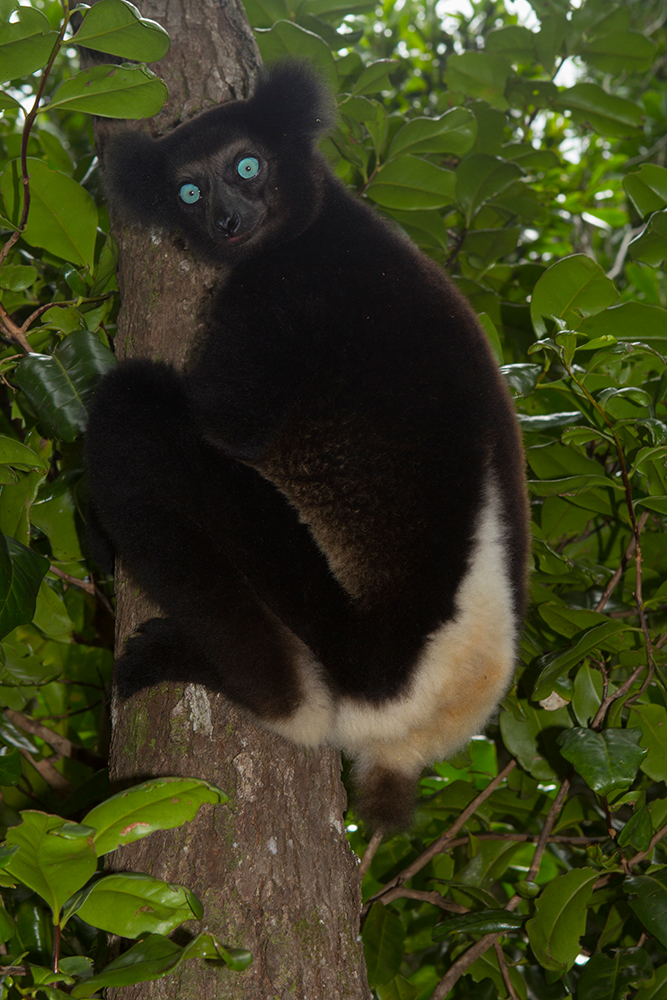 These parks are the ideal spots to observe the endangered Indri lemurs in their natural habitat.
These parks are the ideal spots to observe the endangered Indri lemurs in their natural habitat.
The Indri indri Lemur is one of the few remaining refuges for endangered species, the only guarantee for their livelihood.
While some species can still rely on conservation efforts in zoological environments, this is not the case for the Indri indri Lemur, whose conservation in captivity is impossible, mainly due to its highly varied diet.
The Indri Lemur requires at least thirty different types of leaves to ensure its diet is satisfactory.
Knowing that the Indri can consume up to sixty different types of leaves in its natural habitat, it is clear that the conditions of its diet in a
Indri lemurs, also known as Babakoto by the local population, are territorial animals that spend most of their time high up in the trees of the tropical forests in eastern Madagascar, living in small groups led by female Indris.
These groups typically start their days with songs that can be heard from over three kilometers away:
Local communities near these groups often communicate daily through vocal exchanges, which contribute to the unique behavior of the Indri lemurs.
The amazing nature was even the subject of a study to understand its full extent.
It is known for its very powerful territorial claims.

